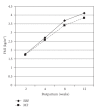Association between Infant Feeding and Early Postpartum Infant Body Composition: A Pilot Prospective Study
- PMID: 20041019
- PMCID: PMC2778447
- DOI: 10.1155/2009/648091
Association between Infant Feeding and Early Postpartum Infant Body Composition: A Pilot Prospective Study
Abstract
Research studies have produced conflicting results of the impact of breastfeeding on overweight/obesity. This study evaluated the impact of infant feeding on infant body composition. There were two groups of mother-infant pairs (exclusive breastfeeding [EBF; n = 27] and mixed feeding [MF; n = 13]) in this study. At baseline, participants were similar in their demographic characteristics except prepregnancy weight, where MF mothers tended to be heavier than their EBF counterparts (67.3 kg versus 59.9 kg; P = .034). Infant birth weight was slightly higher among the MF group than their EBF counterparts (3.5 kg versus 3.4 kg), although the differences were not statistically significant. At 3 months postpartum, mean infant FMI (4.1 kg/m(2) versus 3.8 kg/m(2)) and percent body fat (24.4% versus 23.1%) were slightly higher among EBF infants than MF infants. In terms of growth velocity, EBF infants gained weight faster than their MF counterparts, although the differences were not statistically significant. The findings from this study suggest that EBF may promote faster weight gain and increase in both fat mass index (FMI) and percent body fat in the early postpartum period in addition to the numerous health benefits enjoyed by the infant and the mother who exclusively breastfeeds her newborn.
Figures



Similar articles
-
Exclusivity of breastfeeding and body composition: learnings from the Baby-bod study.Int Breastfeed J. 2021 May 19;16(1):41. doi: 10.1186/s13006-021-00389-x. Int Breastfeed J. 2021. PMID: 34011366 Free PMC article.
-
Effects of breastfeeding on weight loss and recovery of pregestational weight in adolescent and adult mothers.Food Nutr Bull. 2013 Jun;34(2):123-30. doi: 10.1177/156482651303400201. Food Nutr Bull. 2013. PMID: 23964385
-
Effect of infant feeding on maternal body composition.Int Breastfeed J. 2008 Aug 6;3:18. doi: 10.1186/1746-4358-3-18. Int Breastfeed J. 2008. PMID: 18684325 Free PMC article.
-
Maternal activity budgets: feasibility of exclusive breastfeeding for six months among urban women in Honduras.Soc Sci Med. 1995 Aug;41(4):527-36. doi: 10.1016/0277-9536(94)00354-v. Soc Sci Med. 1995. PMID: 7481947 Clinical Trial.
-
Interactive Effects of Early Exclusive Breastfeeding and Pre-Pregnancy Maternal Weight Status on Young Children's BMI - A Chinese Birth Cohort.PLoS One. 2015 Dec 7;10(12):e0144357. doi: 10.1371/journal.pone.0144357. eCollection 2015. PLoS One. 2015. PMID: 26641272 Free PMC article.
Cited by
-
Associations of infant feeding with trajectories of body composition and growth.Am J Clin Nutr. 2017 Aug;106(2):491-498. doi: 10.3945/ajcn.116.151126. Epub 2017 Jun 28. Am J Clin Nutr. 2017. PMID: 28659299 Free PMC article.
-
Impact of Early Infant Growth, Duration of Breastfeeding and Maternal Factors on Total Body Fat Mass and Visceral Fat at 3 and 6 Months of Age.Ann Nutr Metab. 2017;71(3-4):203-210. doi: 10.1159/000481539. Epub 2017 Nov 14. Ann Nutr Metab. 2017. PMID: 29136614 Free PMC article.
-
Prolonged exclusive breastfeeding, autumn birth and increased gestational age are associated with lower risk of fever in children with hand, foot, and mouth disease.Eur J Clin Microbiol Infect Dis. 2012 Sep;31(9):2197-202. doi: 10.1007/s10096-012-1555-4. Epub 2012 Jan 26. Eur J Clin Microbiol Infect Dis. 2012. PMID: 22278296
-
Protective effect of exclusive breastfeeding against hand, foot and mouth disease.BMC Infect Dis. 2014 Dec 4;14:645. doi: 10.1186/s12879-014-0645-6. BMC Infect Dis. 2014. PMID: 25471294 Free PMC article.
References
-
- Arenz S, Rückerl R, Koletzko B, von Kries R. Breast-feeding and childhood obesity—a systematic review. International Journal of Obesity. 2004;28(10):1247–1256. - PubMed
-
- Harder T, Bergmann R, Kallischnigg G, Plagemann A. Duration of breastfeeding and risk of overweight: a meta-analysis. American Journal of Epidemiology. 2005;162(5):397–403. - PubMed
-
- Owen CG, Martin RM, Whincup PH, Smith GD, Cook DG. Effect of infant feeding on the risk of obesity across the life course: a quantitative review of published evidence. Pediatrics. 2005;115(5):1367–1377. - PubMed
LinkOut - more resources
Full Text Sources

